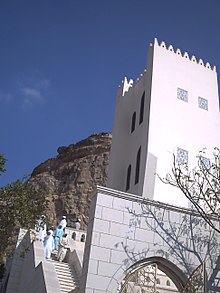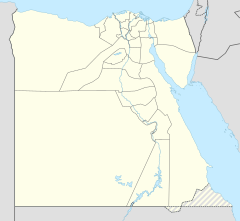
Back مسجد اللؤلؤة Arabic লুলুয়া মসজিদ Bengali/Bangla Mesquita d'al-Lulua Catalan Mezquita de Lulua Spanish Masjid Lulua ID Мечеть Лулуа Russian Umusigiti wa Lulua Kinyarwanda Мечеть Лулуа Ukrainian مسجد لؤلؤہ Urdu Lulua masjidi Uzbek
| Lulua Mosque مسجد اللؤلؤة | |
|---|---|
 The Lulua Mosque in 2010, after its renovation | |
| Religion | |
| Affiliation | Islam |
| District | Cairo Governorate |
| Region | Egypt |
| Status | Active |
| Location | |
| Geographic coordinates | 30°01′11″N 31°16′05″E / 30.01986°N 31.268187°E |
| Architecture | |
| Type | Mosque |
| Style | Fatimid |
| Founder | Al-Hakim bi-Amr Allah |
| Completed | Original in 1015–16 AD, new 1998 |
| Specifications | |
| Dome(s) | 1 |
| Minaret(s) | 1 |
| Materials | limestone, rubble and bricks |
The Lulua Mosque or al-Lu'lu'a Mosque (Arabic: مسجد اللؤلؤة, romanized: Masjid al-Lu'lu'a, lit. 'Mosque of the Pearl') is a mosque in Cairo, Egypt, that was built in 1015–16 AD.[1] It was constructed during the reign of the third[2] Fatimid caliph, al-Hakim, in the Fatimid architectural style.[3] The mosque was almost-fully collapsed in 1919, but was later refurbished in 1998 by the Dawoodi Bohras, who trace their religious lineage to the Fatimid Caliphate's Shia Islam. It is located in the southern cemetery in the Moqattam hills.[1][4]
- ^ a b "Al-Lu'lu'a Mosque". Archived from the original on 29 June 2011. Retrieved 3 December 2010.
- ^ Note: Sources conflict on the period of dating the mosque - either during the reign of the third Fatimid caliph (per MIT) or of the sixth caliph, in another ("Hakem be-Amr Allah" Archived 17 May 2019 at the Wayback Machine entry, Encyclopædia Iranica Vol. 11, pp. 572-573, ed. Ehsan Yarshater. Encyclopædia Iranica Foundation & Eisenbrauns, Inc., New York, 2003). MIT is cited here, pending agreement of authoritative sources.
- ^ "5 – Fatimid Mosques in Cairo". Massachusetts Institute of Technology. Archived from the original on 7 January 2023. Retrieved 8 March 2013.
- ^ Williams, Caroline; Williams, Caroline H. (2008). Islamic Monumentss in Cairo: The Practical Guide. American Univ in Cairo Press. p. 279. ISBN 978-977-416-205-3.
